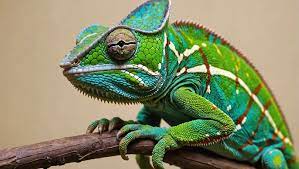Chameleons are fascinating creatures. Known for their vivid colors and slow, deliberate movements, they captivate reptile enthusiasts and curious observers alike. But if you’re a chameleon owner—or considering becoming one—there’s one question you’re likely wondering: How often should my chameleon eat?
Feeding your chameleon the right amount of food is crucial for its health and well-being, and the answer isn’t as simple as it may seem. Factors like age, species, activity level, and even the seasons all play a role in determining how often you should feed your pet.
In this comprehensive guide, we’ll dive into the dietary needs of chameleons, the factors that affect their feeding frequency, and practical tips to ensure you’re meeting their nutritional needs. Whether you’re a new chameleon owner or an experienced one, by the end of this article, you’ll have the knowledge you need to provide your chameleon with a healthy and balanced diet.
Understanding Chameleon Eating Habits

The Natural Diet of a Chameleon
Before diving into how often chameleons eat, it’s important to understand what they eat. Chameleons are primarily insectivores, meaning their diet is made up mostly of insects. However, depending on the species, some chameleons may also consume a variety of leaves, flowers, and fruits.
In the wild, chameleons are opportunistic hunters, carefully selecting their prey. They have specialized eyes that can move independently, allowing them to survey their environment for potential meals without moving their bodies. Once they spot an insect, they strike with their long, sticky tongue, often capturing prey from a surprising distance.
While insects are the main part of their diet, some species, like the Veiled Chameleon, will also eat plant matter. This helps provide essential nutrients like fiber and hydration, making their diet more balanced. Understanding their natural diet helps us provide a diet that mimics their wild eating habits.
Chameleon Digestive System
A chameleon’s digestive system is designed to process a variety of foods, but it requires the right amount of time to break down and absorb nutrients. That’s why feeding frequency plays a critical role in keeping your chameleon healthy. Overfeeding can lead to digestive issues, while underfeeding can lead to malnutrition.
Now, let’s break down the frequency of feeding based on different factors.
General Feeding Guidelines
How Often Should Young Chameleons Eat?
For younger chameleons (under six months), feeding frequency is higher. This is because they have faster metabolisms and need more energy for growth and development. A baby chameleon typically needs to be fed every day—sometimes even twice a day if it’s particularly active and growing rapidly.
The amount of food provided should be enough to fill the chameleon’s stomach, but not so much that it becomes overweight. Baby chameleons can eat smaller insects like crickets, fruit flies, or small roaches. They should also receive a variety of food to ensure they get the necessary nutrients for healthy growth.
How Often Should Adult Chameleons Eat?
Once chameleons reach adulthood (typically around six months old), their metabolism slows down, and they require less frequent feeding. Most adult chameleons should be fed every other day or 3-4 times a week depending on the species and individual needs.
Species such as the Panther Chameleon may need to eat more frequently due to their higher activity levels, while others like the Jackson’s Chameleon, which tends to be more sedentary, may eat less often.
Feeding Frequency for Female vs. Male Chameleons
Feeding frequency can also vary between male and female chameleons, especially during mating seasons. Female chameleons that are gravid (carrying eggs) may eat more frequently to support their reproductive health. They will need additional nutrients, particularly calcium, during this period to avoid complications such as metabolic bone disease.
Male chameleons, on the other hand, typically eat less during breeding seasons because they focus more on courtship behaviors than on food consumption.
Factors Affecting How Often Chameleons Eat

Age and Growth Stages
As mentioned, younger chameleons need to eat more often to support their rapid growth. Chameleons grow quickly during their first few months of life, so feeding them daily provides the energy they need to develop properly. As they age, however, their growth slows down, and they will require less food. It’s essential to adjust their diet as they grow to avoid obesity or other health issues.
Species-Specific Needs
Different species of chameleons have varying feeding needs. Some chameleons are more active and need more food, while others are more sedentary and require less. For example, the Veiled Chameleon, a popular pet species, is quite active and will need more food than a more relaxed species like the Jackson’s Chameleon.
Make sure to research the specific dietary needs of the species you own to ensure you’re feeding them the right amount.
Activity Level and Metabolism
A chameleon’s activity level directly affects how often they need to eat. Active chameleons that roam around their enclosure hunting insects will require more food to fuel their energy. If your chameleon seems particularly active or restless, it may be a sign that it needs more frequent feedings.
In contrast, less active chameleons or those that seem lethargic may be a sign that they need fewer meals.
Seasonal Variations
Just like in the wild, seasonal changes can affect a chameleon’s eating habits. During colder months or in captivity, chameleons may become less active and require fewer meals. On the other hand, during warmer months, when food is more abundant in the wild, they may eat more frequently.
If your chameleon lives in an enclosure where temperature and lighting are controlled, it may not exhibit the same seasonal behavior. However, it’s still important to observe your chameleon’s behavior and adjust its feeding schedule accordingly.
How to Determine If You’re Feeding Your Chameleon Correctly
Signs of Overfeeding
Overfeeding can lead to obesity, which can cause a range of health problems such as lethargy, difficulty moving, and even organ failure. If your chameleon seems to be gaining too much weight, you may be feeding it too often or too much food at once. Signs to watch for include:
- Lethargy or lack of movement
- Difficulty climbing or moving around
- An unusually large belly
Signs of Undernourishment
On the flip side, underfeeding can cause malnutrition and weakened immune function. If your chameleon is underfed, it may show signs like:
- Weight loss or a noticeably sunken belly
- Lethargy or lack of interest in food
- Skin discoloration or shedding problems
If you notice any of these signs, it’s time to reassess your feeding routine. Chameleons are notoriously sensitive, and a poor diet can lead to long-term health issues.
Common Feeding Mistakes to Avoid
Feeding Too Often or Too Little
One of the most common mistakes chameleon owners make is feeding either too often or too infrequently. While it’s tempting to overfeed your chameleon to ensure it’s getting enough nutrition, this can lead to obesity and other health problems. Conversely, underfeeding can lead to malnutrition and stunt growth.
Make sure to adjust your feeding routine based on your chameleon’s age, species, and activity level.
Feeding the Wrong Types of Food
Not all foods are suitable for chameleons. Avoid feeding them iceberg lettuce, as it offers little nutritional value. Also, steer clear of insects that are too large or too small, as they can cause choking or digestive issues. Stick to insects that are about the size of your chameleon’s head for optimal feeding.
Inconsistent Feeding Times
Chameleons thrive on routine. Feeding your chameleon at the same time each day—or every other day—helps establish a predictable schedule, making it easier for your pet to adjust. Inconsistent feeding times can confuse your chameleon and cause unnecessary stress.
Tips for Creating a Healthy Feeding Schedule
Feeding Time Consistency
Whether you’re feeding your chameleon daily or every other day, consistency is key. Establish a feeding schedule and stick to it. This helps regulate your chameleon’s metabolism and ensures it’s receiving the proper amount of food.
Using Feeding Tools
Feeding tools like feed cups or live plants can help make mealtime more exciting and natural for your chameleon. Some chameleons enjoy foraging for their food, so consider providing them with a mix of live plants that they can explore while looking for insects.
Hydration
Chameleons don’t drink from water bowls like other reptiles. They need to be misted regularly, as they drink droplets from leaves and surfaces. Proper hydration is essential for digestion, and without it, your chameleon might not eat as often or may suffer from dehydration.
Conclusion
Feeding your chameleon goes beyond simply offering food—it’s about providing the right food at the right time. By understanding your chameleon’s unique dietary needs, you can establish a feeding schedule that promotes their overall health and well-being.
When asking How often do chameleons eat?, it’s important to remember that feeding frequency depends on several factors: age, species, activity level, and even the time of year. Always observe your chameleon’s behavior and body condition to ensure its diet is properly adjusted. With some careful attention and a bit of research, you can ensure your chameleon thrives, enjoying a long and healthy life as an engaging and vibrant companion.

